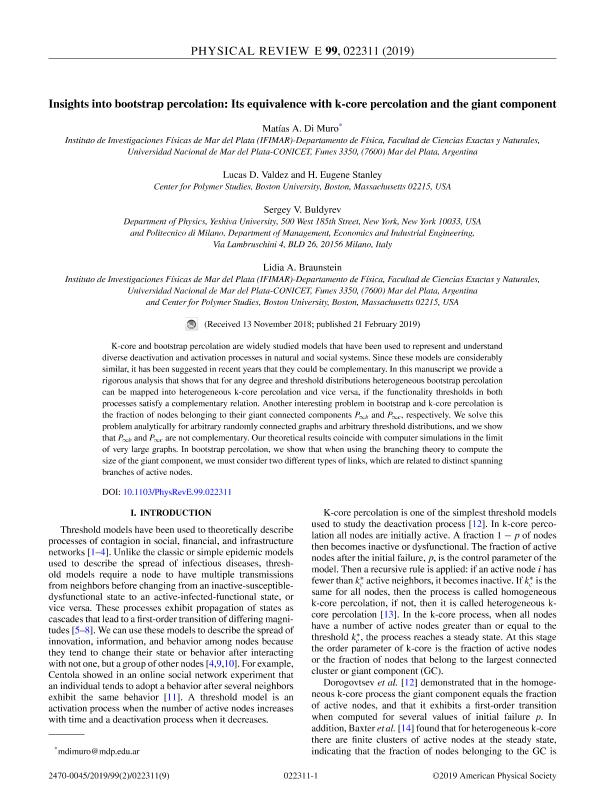Mostrar el registro sencillo del ítem
dc.contributor.author
Di Muro, Matias Alberto

dc.contributor.author
Valdez, Lucas Daniel

dc.contributor.author
Stanley, Harry Eugene

dc.contributor.author
Buldyrev, Sergey V.
dc.contributor.author
Braunstein, Lidia Adriana

dc.date.available
2021-01-18T19:27:31Z
dc.date.issued
2019-02
dc.identifier.citation
Di Muro, Matias Alberto; Valdez, Lucas Daniel; Stanley, Harry Eugene; Buldyrev, Sergey V.; Braunstein, Lidia Adriana; Insights into bootstrap percolation: Its equivalence with k-core percolation and the giant component; American Physical Society; Physical Review E; 99; 2; 2-2019
dc.identifier.issn
2470-0045
dc.identifier.uri
http://hdl.handle.net/11336/122919
dc.description.abstract
K-core and bootstrap percolation are widely studied models that have been used to represent and understand diverse deactivation and activation processes in natural and social systems. Since these models are considerably similar, it has been suggested in recent years that they could be complementary. In this manuscript we provide a rigorous analysis that shows that for any degree and threshold distributions heterogeneous bootstrap percolation can be mapped into heterogeneous k-core percolation and vice versa, if the functionality thresholds in both processes satisfy a complementary relation. Another interesting problem in bootstrap and k-core percolation is the fraction of nodes belonging to their giant connected components P∞b and P∞c, respectively. We solve this problem analytically for arbitrary randomly connected graphs and arbitrary threshold distributions, and we show that P∞b and P∞c are not complementary. Our theoretical results coincide with computer simulations in the limit of very large graphs. In bootstrap percolation, we show that when using the branching theory to compute the size of the giant component, we must consider two different types of links, which are related to distinct spanning branches of active nodes.
dc.format
application/pdf
dc.language.iso
eng
dc.publisher
American Physical Society

dc.rights
info:eu-repo/semantics/openAccess
dc.rights.uri
https://creativecommons.org/licenses/by/2.5/ar/
dc.subject
Complex Networks
dc.subject
Percolation
dc.subject
Bootstrap
dc.subject
k-core
dc.subject.classification
Otras Ciencias Físicas

dc.subject.classification
Ciencias Físicas

dc.subject.classification
CIENCIAS NATURALES Y EXACTAS

dc.title
Insights into bootstrap percolation: Its equivalence with k-core percolation and the giant component
dc.type
info:eu-repo/semantics/article
dc.type
info:ar-repo/semantics/artículo
dc.type
info:eu-repo/semantics/publishedVersion
dc.date.updated
2020-11-30T14:18:01Z
dc.journal.volume
99
dc.journal.number
2
dc.journal.pais
Estados Unidos

dc.description.fil
Fil: Di Muro, Matias Alberto. Consejo Nacional de Investigaciones Científicas y Técnicas. Centro Científico Tecnológico Conicet - Mar del Plata. Instituto de Investigaciones Físicas de Mar del Plata. Universidad Nacional de Mar del Plata. Facultad de Ciencias Exactas y Naturales. Instituto de Investigaciones Físicas de Mar del Plata; Argentina
dc.description.fil
Fil: Valdez, Lucas Daniel. Boston University; Estados Unidos
dc.description.fil
Fil: Stanley, Harry Eugene. Boston University; Estados Unidos
dc.description.fil
Fil: Buldyrev, Sergey V.. Yeshiva University; Estados Unidos
dc.description.fil
Fil: Braunstein, Lidia Adriana. Politecnico di Milano; Italia
dc.journal.title
Physical Review E
dc.relation.alternativeid
info:eu-repo/semantics/altIdentifier/url/https://link.aps.org/doi/10.1103/PhysRevE.99.022311
dc.relation.alternativeid
info:eu-repo/semantics/altIdentifier/doi/https://doi.org/10.1103/PhysRevE.99.022311
Archivos asociados
